Waders in Wales

Over Halloween weekend I made a trip to Wales to take part in a wader ringing weekend organised by SCAN ringing group coordinated by fellow ex-Curlew field worker Steve Dodd. A busy weekend which involved mist netting Friday night and a cannon “shoot” on Saturday and Sunday. Ringing took place in a nature reserve between Bangor and Conwy in north Wales. After 11 hours of travel (bus x 3, ferry, train & a lift from Rachel), I met the assembled team (in the dark) who had set the mist nets. Base camp was set up (where birds would be ringed and processed) and I borrowed a set of waders (thanks Emilie) to join the extraction team in the wet muddy parts of the reserve.
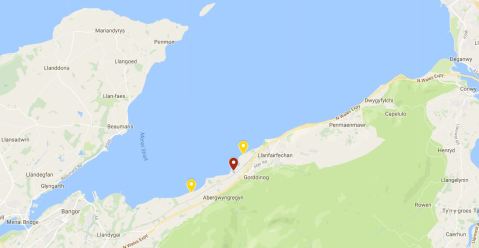
Approximate locations of mist netting (red) and cannon netting (yellow) sites
After a welcome slow start (allowing adjustment to the dark & the mud) the birds arrived and began appearing in the nets attracted by the tapes. We worked carefully, without light where possible, to extract the waders. Despite my experience with passerines, I found the extraction quite difficult, however Steve & Richard were always close by to help and offer tips. About an hour after high tide we closed the nets and went to assist the ringing & processing team. In total 82 Redshank, 34 Dunlin, 2 Curlew, 2 Black-tailed Godwits and a single Knot were caught. Once the last bird was released, all equipment was swiftly packed up and it was home for a few hours sleep before an early start to set cannon nets.
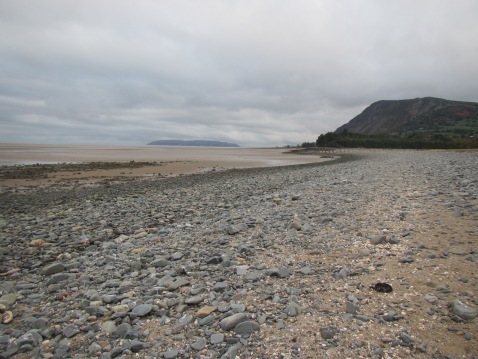
Looking north along the coast at Llanfairfechan – close to the cannon net site
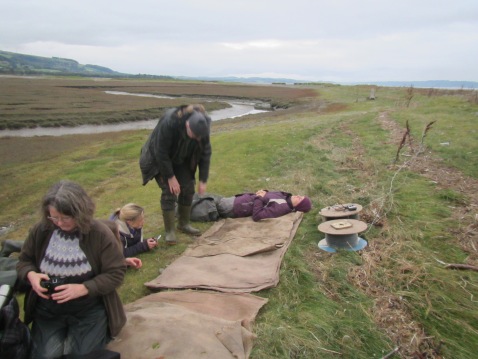
Getting comfortable next to the cables to wait for high tide to push birds close to the nets
Although this was my second time attending a cannon net “shoot” it was a very different experience. As the nets were being set from scratch each day I got to experience the whole process from start to finish. This gave me more of an understanding and appreciation of how much time, equipment and expertise is involved in cannon netting (and how many factors need to come together for it to work). I was delighted to be involved in many different parts (especially the connecting up the “chocolate blocks“) and everyone made sure I felt like part of the team and was kept busy!
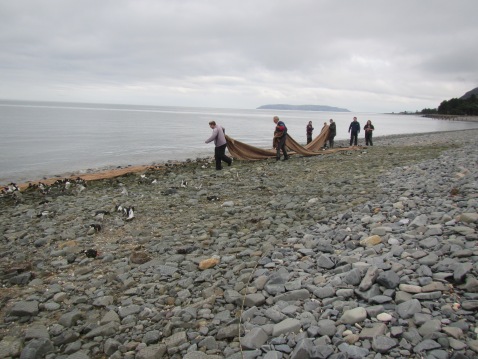
One of the first steps in the process is to cover the birds to keep them calm
After multiple briefings and what seemed like an eternity (patience is very important!), I heard the magic words “3,2,1” followed by bang. Everyone dashed to the net and got to work covering, extracting, placing birds in keeping cages and finally ringing and releasing.

The team working together to extract birds and shuttle them to the keeping cages
Once birds were safely in keeping cages, we divided up into teams and the ringing and processing began.
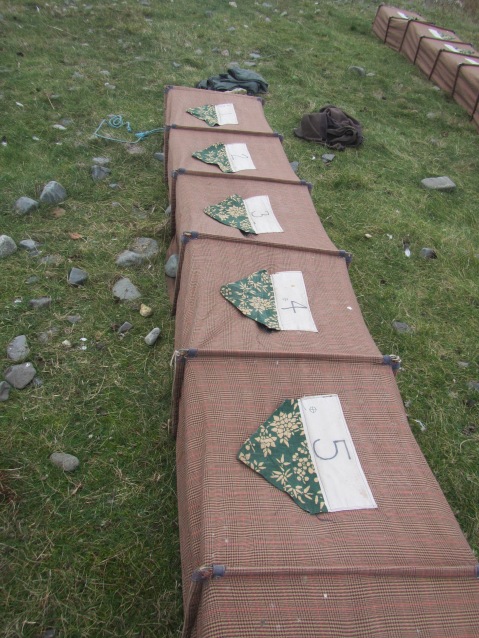
The numbered keeping cages, made from heavy duty fabric, have velcro “lids” with an opening underneath for inserting and removing birds
Among the 418 Oystercatchers (the target species for the catch) and 25 Curlew caught we had one Bar-tailed Godwit and one Black-tailed Godwit. I was given the chance to ring the Bar-tailed Godwit and it was a great opportunity to see these two very similar species up close and compare their differentiating features.
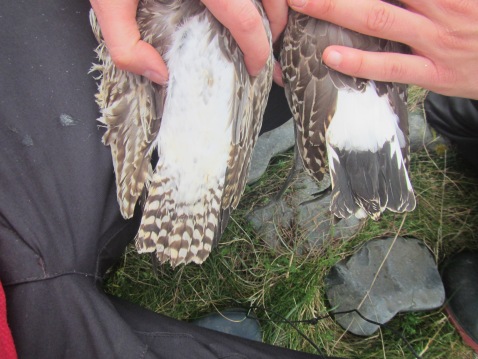
Comparing the tails of Bar-tailed Godwit (left) and Black-tailed Godwit (right)

Ageing and ringing the Oystercatchers – all overseen by Dave and Richard

The processing team lead by Steve & Rachel with Tom, Will & Orinoco to keep everyone company!
About one third of the Oystercatchers caught were already ringed. The majority of these were ringed in previous years by the SCAN group (retraps), with the oldest retrap of the day being 29 years old – older than quite a few members of the ringing group. The record for the longest living Oystercatcher in the BTO ringing scheme currently stands at 40 years, 1 month and 2 days. Among the ringed birds, we had 3 foreign controls, ringed in Iceland including JA a colour ringed bird. Initially I thought the colour ring was not white, but faded yellow meaning it could belong to the Dublin Bay Birds Project, but I was wrong, it was just dirty!
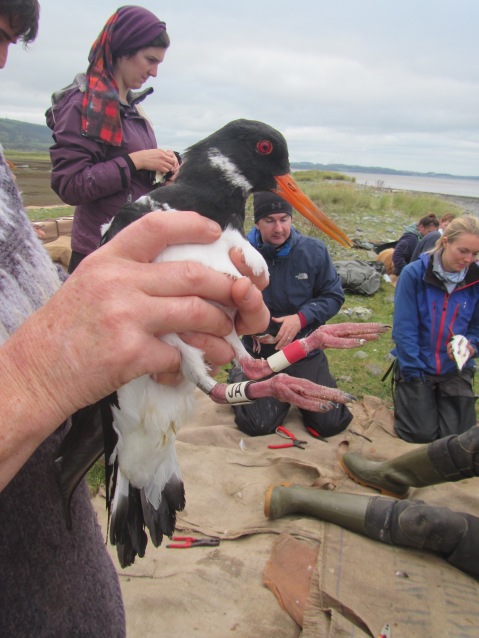
Oystercatcher (JA) originally colour ringed in Iceland controlled by SCAN ringing group in North Wales
By mid afternoon all birds had been ringed and released and it was time to pack up. Another efficient clean up operation meant more time available for tea drinking and rest. On Sunday morning a net was set in a green field, before high tide, with the aim of catching Curlew. After all equipment was set up, I was given the opportunity to be part of the team that would sit in the hide, so I had a birds eye view of moments before the net being shot.
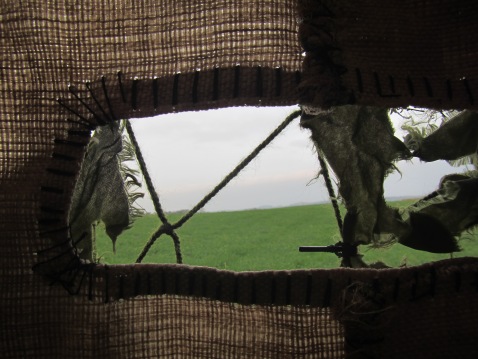
View from the inside of the hide
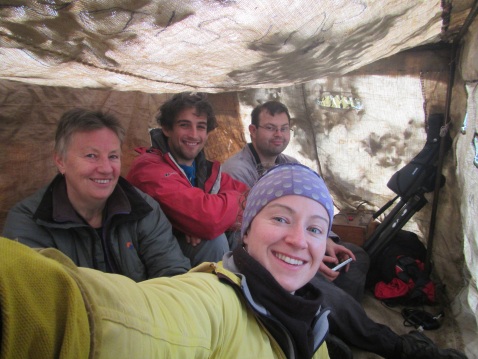
Hide Team – with Ava, Tom and Richard
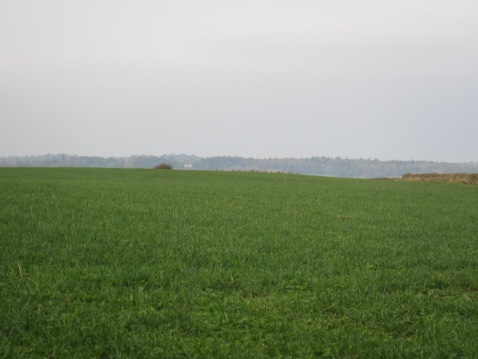
Curlew gathering next to decoys in the field just below the tree line
A few new pieces of equipment were introduced to me, including the hide and the “jiggler” (not the gigolo as I called it) – a simple but useful piece of string used to gentle encourage the birds away from the area immediately in front of the cannons (it appears cannon netting has it’s only set of terminology!)

Some of the team members ringing and processing Curlew
I thoroughly enjoyed a very well organised weekend catching waders with a group of knowledgeable and friendly ringers. I would definitely recommend a visit for any ringer interested in experiencing cannon netting.
Finally catch totals for the weekend (from my notes):
- 418 Oystercatcher
- 82 Redshank
- 47 Curlew
- 34 Dunlin
- 3 Black-tailed Godwit
- 1 Bar-tailed Godwit
- 1 Knot
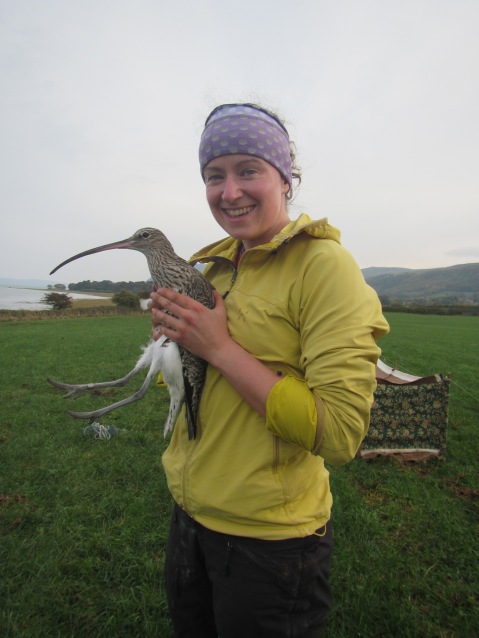
It’s been a Curlew year for me – from surveying on the breeding grounds in the summer to ringing on the coast in the winter
West Coast Wheatears
Over the past few weeks I have assisted a local ringer (Arne, who also sells some useful foldable net poles for ringing) at two of his local patches close to the Danish west coast. Both sites are located within the boundaries of Thy national park, one at an old farm site, surrounded by conifer plantation and the second on a long narrow peninsula (Agger Tange) which separates a fjord (Limfjord) and the North Sea.
During my two visits we caught three Northern Wheatear (Oenanthe oenanthe) known as ‘stenpikker’ in Danish, two at the farm and one at Agger Tange. On the 30th of April we caught two birds, one with a wing 93mm (referred to as W1 for ease of reference) and the second with a wing of 92mm (W2) together, next to each other in a net, at the farm site.
Firstly I was surprised at how similar the two birds were, compared to the images presented in some field guides. It appears that W1 is a male, with silver/blue-grey crown, nape, mantle and back and a while supercilium, together with black lores and wings. However the ear coverts are quite pale, more brownish than other photos and descriptions suggest. W2 had, in general, a similar pattern, but appears “dirtier” with all features less clear cut, more brownish wings, buffier underparts, paler cheek patch etc. which matches the BWP description for females.
In terms of moult and ageing, Jenni & Winkler (1994) informed me that juveniles undergo a partial post juvenile moult (all lesser & median coverts, a variable number of greater coverts and possibly the innermost tertial, carpel covert and smallest alula), while adults perform a complete postbreeding moult. However things get a little more interesting (exciting!) as a small percentage of both adults and second years under go a very restricted partial prebreeding moult (may include lesser & median coverts, inner greater coverts and tertials). This means it may be possible to see 3 generations of feathers in some second year birds; juvenile, post juvenile and prebreeding! This reminds me of many happy days ringing chiffchaffs in Catalonia in the spring of 2014 – exciting times!
Firstly a close look at the male wing (W1). It appears that the inner greater covert has recently been renewed (prebreeding) identified as having a broad greyish brown fringe (see arrow). Some median and lesser coverts may also have been replaced, but it is difficult to see due to my thumb! The remainder of the wing appears to be postbreeding, therefore I assume it to be an adult (3rd calendar year or older).
The female (W2) wing appeared to be in a similarly good condition with dark feathers, but with a more brownish black colour when compared to the male. It is possible that the inner 3 median coverts have been renewed in the prebreeding moult (greyish fringe compared with buff fringe, see arrow). With the presence of two feather generations and the general condition of the wing, I think it could also be an adult (3rd calendar year or more), but I would love to see some second years to compare! Interestingly she had also recently renewed 3 tail feathers (identified as longer with buff tips) on the left hand side, suggesting accidental loss.
On the 8th of May at Agger Tange we caught a another wheatear (W3), with a much longer wing, (104mm, weight 31g). It appeared to be a male, with clean black lores, but showed more brownish tinges in the back, head and mantle.
I must admit, I got quite excited while examining the wing of this bird. It is possible that there are three feather generations in the greater coverts (GC)! The outer greater coverts (1-8) appear to be juvenile, brownish, loose in texture, with pale, worn buff edges, GC9 appears to be post-juvenile (PJ) with a much darker, black centre and buff edge, while GC10 appears to be prebreeding with a greyish fringe as seen in W1 and W2 above (see red labels & arrows below). This presence of 3 feather generations suggests a second calendar year bird (born last year). (Comments welcome on this!)
According to Birds of the Western Palearctic (BWP, 2004) there are four subspecies of Northern Wheatear in the the Western Palearctic. Two are commonly reported in Denmark; the nominate European race (O. o. oenanthe) which breeds in Denmark (ca. 2,000 pairs in 2011; DOF), and the Greenland race (O. o. leucorhoa) which passes Denmark on migration from overwintering grounds in western Africa to breeding grounds in Greenland, Iceland and eastern Canada. It’s worth a mention that research using geolocaters has shown that wheatears make one of the most impressive migration journeys for a passerine.
The Greenland race (leucorhoa) is noticeably larger than the nominate (oenanthe), with bill, wing and tail 15-20% longer and legs 20-30% longer (BWP, 2004). The first two birds we ringed (W1 male and W2 female) had shorter wings (93 and 92 mm respectively) compared with the last bird caught (W3, 104 mm). Wheatears of the nominate subspecies in Denmark were reported to have wing lengths of 94-99 mm (males) and 89-95 mm (females) with slightly smaller birds reported in Norway and Sweden (males 92-99 mm, females 91-97 mm) (BWP). Wing measurements from wheaters in Greenland are much larger (males 101-109, females 99-105) but slightly smaller among breeding birds caught in Iceland (males 99-107, females 96-103) (BWP, 2004). Based on wing measurements it appears that W1 & W2 are of the nominate species, while W3 belongs to the Greenland race (leucorhoa).
In terms of plumage, BWP states leucorhoa from east Canada and Greenland show less blue and apparently no silver or white tones on grey crown and back, with much richer and darker, more uniformly coloured underparts (possibly observed in photo above). However attempting to compare colours in photos taken on different days, with different light conditions, and in different positions, is less than ideal. Also there appears to be age related differences in sexual plumage to consider (first spring males more female like with duller dirtier tones). BWP also states that Icelandic birds are intermediate in size and appearance between the nominate and birds from east Canada and Greenland, confusing matters even more!
During my absence, Arne managed to catch two male wheatears, one of each subspecies. The photos clearly show the size difference between the nominate (left) and Greenland race (right).
Differences in underpart colour is also evident, with the Greenland bird (right) showing a more warm buff colour on the chest / belly that extends down towards the vent.
References & links
Birds of the Western Palearctic Interactive DVD (2004). Gostours; 2.0.3 edition.
Jenni, L. & Winkler, R. (1994): Moult and Ageing of European Passerines. Academic Press, London, UK
Northwest Norfolk ringing group
Arne’s online webshope – selling net poles
Spring signposted!
There is a lot to be said for waymarked or signposted trails – leave your map and compass at home and enjoy a wander, which we have signposted for you. Perfect for an Easter Sunday springtime ramble with Hanne and Max. I was excited to visit this somewhat longer 15km circular route I found on Holsterbo Kommune’s website which winds around Subbergård lake, not far from our farmyard home.
The path, which for the most, part doesn’t stray too far from the lake shore wanders through different habitats, from open heathland and grassland to both deciduous and coniferous forest and there is even a small taste of agricultural land. The weather was, as to be expected in spring, changeable, and we were rewarded with sunshine, rolling clouds and a fresh breeze as we walked.
There were plenty of signs of spring to be seen. The fluffy soft buds of the willow trees were bursting out, and I learned that these are known as “gæslinger” in Danish, which translates to baby geese – how adorable!
I was happy to find a small blanket (more like a rug) of early woodland flowers (Wood Anenome) and at one corner of the lake we spotted a small group of Greater Crested Grebes. To my surprise they were already beginning their exceptionally romantic courtship displays, which includes synchronised swimming, dancing, head shaking and giving each other gifts (mostly wet grass or weeds!). This is a must for everyone to see, and will melt the hearts of even the most cynical!
Anyone who has joined me on an outdoor excursion, is familiar with my slight obsession for poo and poo like objects produced by mammals and birds. The lake side walk offered me many chances to get up close and personal with various forms of excrement – how exciting! I spotted what appeared to be signs of fox, otter and possibly a bird of prey pellet (undigested bones and fur are coughed up by owls, falcons etc.). My favourite was a fox dropping filled with the blue / purple shells of many many beetles (see below). Remember to wash your hands before eating, if you do, like me, decide to play with droppings!
In the ruins of a monastery we also spotted signs of life. Stuck on to the white walls inside the strange shaped building, I counted the remains of over 20 barn swallow (landsvale) nests. It was all very quiet in the old building, but in no time at all the adult birds will reach Denmark, after flying a LONG way from Africa, and will start renovating their nests and starting families. It will get a little crowded in their I imagine! Keep your eyes peeled for returning swallows!
When the sun broke through the clouds we were greeted with many tiny voices singing from the trees. The air was filled with the songs of skylark, robin, wren, coal tit, chaffinch and chiffchaff to name just a few. We were lucky to make it back to the car, with heavy legs and sore toes before the clouds brought rain. I’m looking forward to visiting again and spotting more signs of spring and maybe even summer!

































